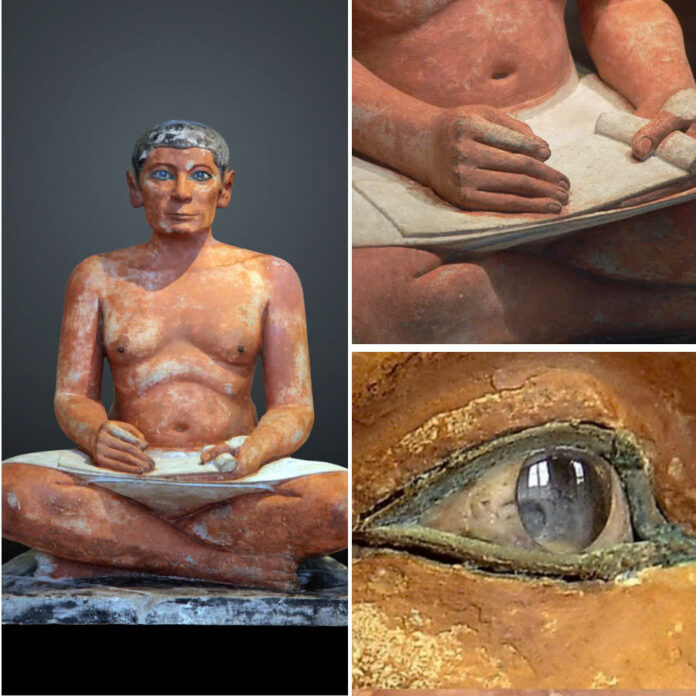In the halls of the Louvre Museum in Paris stands one of ancient Egypt’s most captivating treasures – the ‘Seated Scribe’. This remarkable sculpture, dating back to the Old Kingdom period, tells a story that transcends its 4,500-year history through its extraordinary craftsmanship and lifelike details.
The Discovery of a Hidden Gem

In 1850, French archaeologist Auguste Mariette made a groundbreaking discovery in Saqqara, an ancient necropolis near Cairo. Near the legendary line of sphinxes leading to the Serapeum, he unearthed what would become one of the most celebrated pieces of Egyptian art. Though the exact location remains a mystery due to lost excavation records, the significance of this find would forever change our understanding of ancient Egyptian artistry.
A Marvel of Ancient Craftsmanship
The Eyes That Captivate


What immediately draws viewers to the Seated Scribe are his remarkably lifelike eyes. The ancient artisans created these mesmerizing features using an ingenious combination of materials: red-veined white magnesite, polished rock crystal, and a mysterious organic material that gives the iris its striking blue color. Two copper clips hold these intricate eyes in place, demonstrating the sophisticated technical skills of Egyptian craftsmen.
The Body That Tells a Story

The sculpture’s limestone body, though seemingly simple, speaks volumes about ancient Egyptian society. The scribe’s slightly rounded physique wasn’t a flaw in design but a deliberate artistic choice, symbolizing his privileged position and wealth. Unlike the muscular depictions of soldiers or laborers, his softer form reflected a life devoted to intellectual pursuits rather than physical toil.
A Window into Ancient Egyptian Society
The Seated Scribe represents more than just artistic excellence – it offers invaluable insights into the social structure of ancient Egypt. Scribes held esteemed positions as the recordkeepers and administrators of their time. The figure’s cross-legged posture, with a papyrus scroll across his lap and hands poised for writing, captures the essence of his crucial role in society.

The scribe’s direct gaze, enhanced by those remarkable crystal eyes, creates an almost supernatural connection with viewers. His expression, alert and attentive, suggests he’s ready to record important information, just as he would have done thousands of years ago.
Video
A Legacy That Endures
Despite the passing millennia, the Seated Scribe has survived in remarkable condition, retaining much of its original paint and intricate details. Its discovery may be shrouded in mystery due to lost documentation, but its impact on our understanding of ancient Egyptian art and culture is undeniable.

This masterpiece stands as a testament to a civilization that valued both artistic excellence and intellectual pursuit. It represents a departure from the more rigid, idealized royal portraits of its time, showcasing instead a stunning level of realism and individuality that continues to captivate audiences today.

The Seated Scribe remains not just a sculpture but a bridge across time, connecting us to the rich cultural heritage of ancient Egypt. Through its lifelike features and symbolic elements, it continues to tell stories of a civilization whose artistic achievements still inspire wonder and admiration in the modern world.

